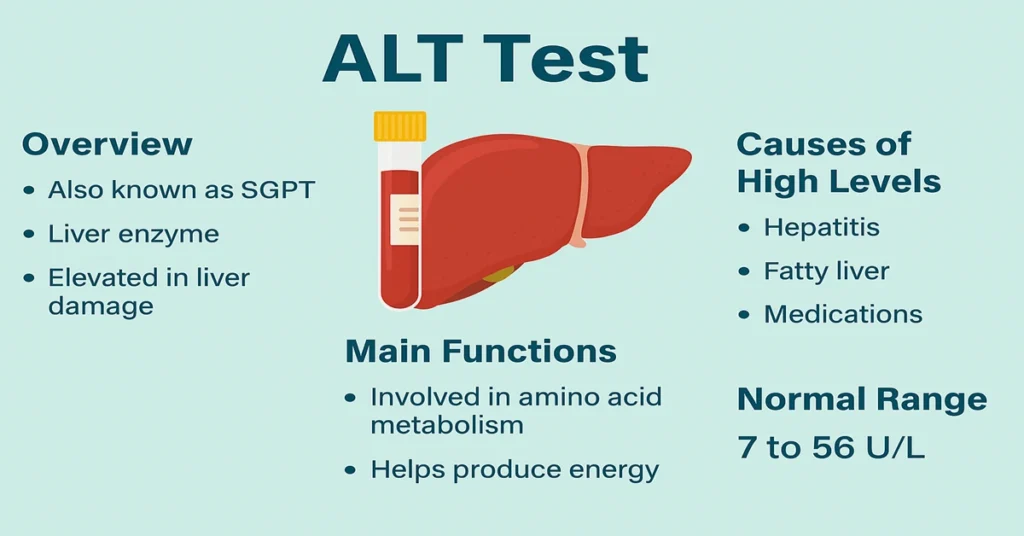What is ALT?
ALT (Alanine Aminotransferase), also known as SGPT (Serum Glutamic-Pyruvic Transaminase), is an enzyme mostly found in the liver. Small amounts are also present in the kidneys, heart, and muscles. When liver cells are damaged or stressed, ALT leaks into the bloodstream, so high ALT levels are usually linked with liver problems. The ALT blood test measures this enzyme and is one of the most important markers for liver health.
Where is it Produced in the Body?
- ALT is mainly produced inside liver cells (hepatocytes).
- Small amounts are found in kidneys, heart, and muscles, but it is highly liver-specific, which makes it a reliable liver test.
Main Functions and Importance
Helps in protein metabolism by converting the amino acid alanine into pyruvate, which produces energy for the body. Plays a role in cellular energy production.
Medical use:
- Detecting liver damage
- Monitoring liver diseases like hepatitis, fatty liver, cirrhosis
- Checking side effects of medications
- Tracking liver treatment progress
Causes of Low ALT Levels
Low ALT is usually not a concern. Possible reasons include:
- Vitamin B6 deficiency
- Severe or end-stage liver failure (very few healthy cells left)
- Normal variation in some healthy individuals
Symptoms of Low ALT
Low ALT itself does not cause symptoms. If very low due to severe liver failure, a person may experience:
- Extreme tiredness
- Pale skin
- Poor digestion
- Mental confusion
Causes of High ALT Levels
High ALT usually means liver cells are damaged. Common causes:
- Hepatitis (viral, autoimmune, or drug-induced)
- Fatty liver disease (NAFLD/NASH)
- Alcohol-related liver injury
- Liver cirrhosis
- Liver cancer or spread of cancer to liver
- Side effects of medicines (e.g., anti-TB drugs, statins, painkillers)
- Toxin exposure (alcohol, herbs, supplements)
- Obstructive jaundice (bile duct blockage)
Symptoms of High ALT
High ALT itself doesn’t cause symptoms, but related liver problems may include:
- Yellowing of skin and eyes (jaundice)
- Dark urine
- Loss of appetite
- Tiredness or weakness
- Nausea or vomiting
- Pain in the upper right side of abdomen
Reference Range
- ALT Normal Range: 7 to 56 U/L
- (Values may slightly differ across laboratories)
Note: ALT is more specific to liver injury than AST, making it a very reliable test for liver health.
Sample Type
- Sample: Serum (blood sample)
- Tube: Red Top (Plain Tube)
Test Preparation
- No special preparation is needed for ALT.
- However, some doctors may ask you to fast for 8–12 hours before the test if it is done along with other liver function tests.
- Avoid alcohol for at least 24 hours before the test, as it can raise ALT levels.
- Inform your doctor about any medicines or supplements you are taking, since some drugs (statins, antibiotics, anti-TB drugs) can affect liver enzyme results.
When to Consult a Doctor
You should consult a doctor if:
- Your ALT levels are higher than normal in a lab report.
- You have jaundice (yellow skin/eyes).
- You notice dark urine, pale stools, or unexplained fatigue.
- You experience upper right abdominal pain.
- You are on long-term medications (like statins or TB drugs) and want to monitor liver health.
Important Word Explanations
- Liver Enzymes: Special proteins in the liver that help with chemical reactions. ALT is one of them.
- Jaundice: Yellow discoloration of skin/eyes caused by excess bilirubin in the blood.
- Cirrhosis: Severe scarring of the liver due to long-term damage.
- Fatty Liver: Condition where extra fat builds up in the liver, often linked with obesity or alcohol use.
~END~


This piece of writing offers clear idea for the new visitors of blogging, that
in fact how to do running a blog.